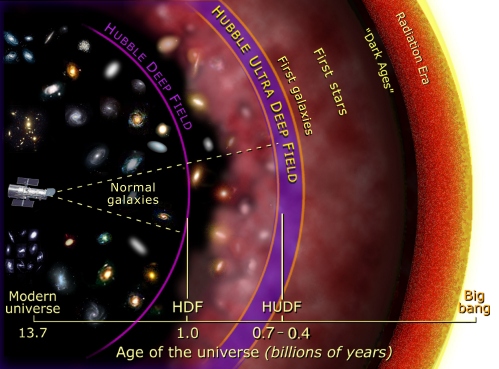
Press Release No.: STScI-2004-07
March 9, 2004
Hubble's Deepest View Ever of the Universe Unveils Earliest Galaxies [Extract]
Astronomers at the Space Telescope Science Institute today unveiled the deepest portrait of the visible universe ever achieved by humankind. Called the Hubble Ultra Deep Field (HUDF), the million-second-long exposure reveals the first galaxies to emerge from the so-called "dark ages", the time shortly after the big bang when the first stars reheated the cold, dark universe. The new image should offer new insights into what types of objects reheated the universe long ago.
"Hubble takes us to within a stone's throw of the big bang itself", says Massimo Stiavelli of the Space Telescope Science Institute in Baltimore, Md., and the HUDF project lead. The combination of ACS and NICMOS images will be used to search for galaxies that existed between 400 and 800 million years (corresponding to a redshift range of 7 to 12) after the big bang. A key question for HUDF astronomers is whether the universe appears to be the same at this very early time as it did when the cosmos was between 1 and 2 billion years old.
The final ACS image, assembled by Anton Koekemoer of the Space Telescope Science Institute, is studded with a wide range of galaxies of various sizes, shapes, and colors. In vibrant contrast to the image's rich harvest of classic spiral and elliptical galaxies, there is a zoo of oddball galaxies littering the field. Some look like toothpicks; others like links on a bracelet. A few appear to be interacting. Their strange shapes are a far cry from the majestic spiral and elliptical galaxies we see today. These oddball galaxies chronicle a period when the universe was more chaotic. Order and structure were just beginning to emerge.
The NICMOS sees even farther than the ACS. The NICMOS reveals the farthest galaxies ever seen, because the expanding universe has stretched their light into the near-infrared portion of the spectrum. "The NICMOS provides important additional scientific content to cosmological studies in the HUDF", says Rodger Thompson of the University of Arizona and the NICMOS Principal Investigator. The ACS uncovered galaxies that existed 800 million years after the big bang (at a redshift of 7). But the NICMOS may have spotted galaxies that lived just 400 million years after the birth of the cosmos (at a redshift of 12). Thompson must confirm the NICMOS discovery with follow-up research.
Galaxies evolved so quickly in the universe that their most important changes happened within a billion years of the big bang. "Where the HDFs showed galaxies when they were youngsters, the HUDF reveals them as toddlers, enmeshed in a period of rapid developmental changes", Stiavelli says.
Hubble's ACS allows astronomers to see galaxies two to four times fainter than Hubble could view previously, and is also very sensitive to the near-infrared radiation that allows astronomers to pluck out some of the farthest observable galaxies in the universe. This will hold the record as the deepest-ever view of the universe until ESA, together with NASA, launches the James Webb Space Telescope in 2011.
The HUDF observations began Sept. 24, 2003 and continued through Jan. 16, 2004. The telescope's ACS camera, the size of a phone booth, captured ancient photons of light that began traversing the universe even before Earth existed. Photons of light from the very faintest objects arrived at a trickle of one photon per minute, compared with millions of photons per minute from nearer galaxies.
TIFF and JPEG images, and press release texts are available via World Wide Web at
Hubble's Deepest View Ever of the Universe Unveils Earliest Galaxies
(HubbleSite - NewsCenter. March 9, 2004)
The Space Telescope Science Institute is operated by the Association of Universities for Research in Astronomy, Inc. (AURA), for NASA,
under contract with the Goddard Space Flight Center, Greenbelt, MD.
The Hubble Space Telescope is a project of international cooperation between NASA and the European Space Agency (ESA).
Updated: March 11 '04
Best seen with MS Internet Explorer.
Back: Observatorio ARVAL - Hubble Ultra Deep Field
Messages: